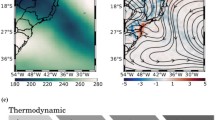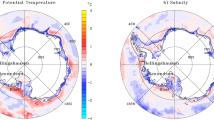Abstract
In this paper we use a coupled ocean–atmosphere model to investigate the impact of the interruption of Agulhas leakage of Indian ocean water on the tropical Atlantic, a region where strong coupled ocean–atmosphere interactions occur. The effect of a shut down of leakage of Indian ocean water is isolated from the effect of a collapse of the MOC. In our experiments, the ocean model is forced with boundary conditions in the southeastern corner of the domain that correspond to no interocean exchange of Indian ocean water into the Atlantic. The southern boundary condition is taken from the Levitus data and ensures an MOC in the Atlantic. Within this configuration, instead of warm and salty Indian ocean water temperature (cold) and salinity (fresh) anomalies of southern ocean origin propagate into the South Atlantic and eventually reach the equatorial region, mainly in the thermocline. This set up mimics the closure of the “warm water path” in favor of the “cold water path”. As part of the atmospheric response, there is a northward shift of the intertropical convergence zone (ITCZ). The changes in trade winds lead to reduced Ekman pumping in the equatorial region. This leads to a freshening and warming of the surface waters along the equator. Especially in the Cold Tongue region, the cold and fresh subsurface anomalies do not reach the surface due to the reduced upwelling. The anomaly signals are transported by the equatorial undercurrent and spread away from the equator within the thermocline. Part of the anomaly eventually reaches the Tropical North Atlantic, where it affects the Guinea Dome. Surprisingly, the main effect at the surface is small on the equator and relatively large at the Guinea Dome. In the atmosphere, the northward shift of the ITCZ is associated with a band of negative precipitation anomalies and higher salinities over the Tropical South Atlantic. An important implication of these results is that the modified water characteristics due to a shut down of the Agulhas leakage remain largely unaffected when crossing the equatorial Atlantic and therefore can affect the deepwater formation in the North Atlantic. This supports the hypothesis that the Agulhas leakage is an important source region for climate change and decadal variability of the Atlantic.











Similar content being viewed by others
References
Biastoch A, Böning CW, Lutjeharms JRE (2008) Agulhas leakage dynamics affects decadal variability in Atlantic overturning circulation. Nature 456:489–492
Bleck R, Rooth C, Hu D, Smith LT (1992) Salinity-driven thermocline transients in a wind- and thermohaline-forced isopycnic coordinate model of the North Atlantic. J Phys Oceanogr 22:1486–1505
Breugem WP, Hazeleger W, Haarsma RJ (2007) Multimodel study of tropical Atlantic variability and change. Geophys Res Lett 33:L23706. doi:10.1029/2006GL027831
Chang P, Zhang R, Hazeleger W, Wen C, Wan X, Ji L, Haarsma RJ, Breugem WP, Seidel H (2008) An oceanic bridge between abrupt changes in North Atlantic climate and the African monsoon. Nat Geosci 1:444–448
Dahl KA, Broccoli AJ, Stouffer R (2005) Assessing the role of North Atlantic freshwater forcing in millennial scale climate variability: a tropical Atlantic perspective. Clim Dyn 24:325–346
Gordon AL (1986) Interocean exchange of thermocline water. J Geophys Res 91(C4):5037–5046
Griffies S et al (more than 8 co-authors) (2009) Coordinated ocean-ice reference experiments (COREs). Ocean Mod 26:1–46
Haarsma RJ, Campos EJD, Molteni F (2003) Atmospheric response to South Atlantic SST dipole. Geophys Res Lett 30(16):1864. doi:10.1029/2003GL017829
Haarsma RJ, Campos EJD, Hazeleger W, Severijns C, Piola AR, Molteni F (2005) Dominant modes of variability in the South Atlantic: a study with a hierarchy of ocean–atmosphere model. J Clim 18:1719–1735
Haarsma RJ, Campos E, Hazeleger W, Severijns C (2008) Influence or the meridional overturning circulation on the tropical Atlantic climate and variability. J Clim 21:1403–1416
Hazeleger WC, Severijns RJ, Haarsma F, Selten A, Sterl (2003a) SPEEDO-model description and validation of a flexible coupled model for climate studies. KNMI, Technical report, TR-257, de Bilt, The Netherlands, pp 37
Hazeleger W, de Vries en P, Friocourt Y (2003b) Sources of the equatorial undercurrent in the Atlantic in a high-resolution ocean model. J Phys Oceanogr 33(4):677–693. doi:10.1175/1520-0485
Hazeleger W, Haarsma RJ (2005) Sensitivity of tropical Atlantic climate to mixing in a coupled ocean–atmosphere model. Clim Dyn 25:387–399. doi:10.1007/s00382-005-0047
Hazeleger W, Drijfhout S (2006) Subtropical cells and meridional overturning circulation pathways in the tropical Atlantic. J Geophys Res 111. doi:10.1029/2005JC002942
Large WG, Yeager SG (2004) Diurnal to decadal global forcing for ocean and sea-ice models: the data sets and flux climatologies. NCAR technical note, NCAR/TN-460+STR, CGD Division
Levitus S, Boyer TP, Conkright ME, O’Brien T, Antonov J, Stephens C, Stathoplos L, Johnson D, Gelfeld R (1998) NOAA atlas NESDIS 18, world ocean database 1998, vol 1: introduction. US Government Printing Office, Washington, p 346
Molteni F (2003) Atmospheric simulations using a GCM with simplified physical parameterizations. I. model climatology and variability in multi-decadal experiments. Clim Dyn 20:175–191
Peeters FJC, Achinson R, Brummer GJA, de Ruijter WPM, Ganssen GM, Schneider RR, Ufkes E, Kroon D (2004) Vigorous exchange between Indian and at the end of the last five glacial periods. Nature 430:661–665
Peterson LC, Haug GH, Hughen KA, Röhl U (2000) Rapid changes in the hydrological cycle of the tropical Atlantic during the last glacial. Science 290:1947–1951
Rintoul SR (1991) South Atlantic interbasin exchange. J Geophys Res 96(C2):2675–2692
Stott L, Poulsen C, Lund S, Thunell R (2002) Super ENSO and global climate oscillations at millennial time scales. Science 297:222–226
Vellinga M, Wood RA (2002) Global climatic impacts of a collapse of the Atlantic thermohaline circulation. Clim Change 54:251–267
Weijer W, de Ruijter WPM, Dijkstra HA, van Leeuwen PJ (1999) Impact of interbasin exchange on the Atlantic overturning circulation. J Phys Oceanogr 29:2266–2284
Xie S-P, Carton JA (2004) Tropical Atlantic variability: patterns, mechanisms and impacts. Ocean-atmosphere interaction and climate variability. Geophys Monogr vol 147, Am. Geophys Union, 121–142
Zhang R, Delworth TL (2005) Simulated tropical response to a substantial weakening of the Atlantic thermohaline circulation. J Clim 18:1853–1860
Acknowledgments
This research is an activity of the South Atlantic Climate Change (SACC) consortium supported by the Inter-American Institute for Global Change Research (IAI), Project CRN2076. The IAI is supported by NSF grant GEO-0452325. The work was started during a 3-month visit of R.J. Haarsma to IOUSP in 2006 and continued during a 2-month visit of E. Campos to KNMI in early 2007. This exchange of visits was mainly supported by FAPESP (Grants 2005/04315-0 and 2006/03939-8). We also acknowledge the additional support from KNMI and CNPq, which provides a Research Fellowship to the second author (Proc. 307785/2004-1).
Author information
Authors and Affiliations
Corresponding author
Rights and permissions
About this article
Cite this article
Haarsma, R.J., Campos, E.J.D., Drijfhout, S. et al. Impacts of interruption of the Agulhas leakage on the tropical Atlantic in coupled ocean–atmosphere simulations. Clim Dyn 36, 989–1003 (2011). https://doi.org/10.1007/s00382-009-0692-7
Received:
Accepted:
Published:
Issue Date:
DOI: https://doi.org/10.1007/s00382-009-0692-7




